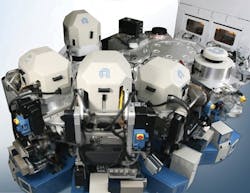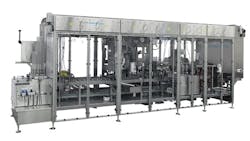Jim Montague is the executive editor for Control. Email him at [email protected].
Extreme Thin Film
For instance, 20 nm geometries and film depositions that are just two to four atomic layers thick push semiconductor manufacturers to combine more process steps in a vacuum environment. Consequently, Applied Materials in Santa Clara, Calif., is hooking up and pumping the air out of more of its wafer-handling mainframe chambers, robotic interfaces and 40 different reactor units.
"Films are getting thinner, and so they're even more sensitive to impurities or oxidization," says Mike Rice, vice president and general manager of Applied's Foundation Engineering division. "As a result, we now have more sequence chambers that must be under vacuum. Users also are applying eight or 10 layers on some microprocessors, where they once applied just two or three, so they need even faster and more precise tools that can complete 20–40 recipes for particular steps."
Three to nine reactors usually are arranged around Applied's Endura mainframe, and they carry out many of the intra-tool, sequential processing steps required to manufacture semiconductor chips, especially those that can't be exposed to atmosphere (Figure 1). In recent years, these mainframe and reactor modules have been designed to conform to increasingly strict mechanical, electrical and software standards, so any chamber can be located next to any other. This uniformity is crucial because Applied Materials typically ships wafer-handling machines just a month after they're ordered, and then assembles and has them running a month after delivery.
"To us, modularity means starting with a base packaging machine and our common bill of materials (BoM) with standard modules that define standard equipment and parts, and then bringing other BoMs into the machine for voltage components, PLC types and different stations and options, such as cappers and film functions," says Scott Bivens, electrical engineering manager at Oystar North America in Covington, Ky., and Davenport, Iowa. "It's a lot like building a pizza. With our modularity, all our designs, BoMs and programs are tested and saved until they're needed. Then, when a particular project order comes along, we can run through a check sheet, and get most of the engineering in place within eight to 10 hours. Traditional, non-modular building means just redoing or copy building a machine that's been done before, and then adding or subtracting required functions. However, because it's not standardized, copy building can take 24–160 hours to do the engineering, depending on the project."
Basic Blocks
While modular methods help builders design and construct their machines, they're even more beneficial to users. For instance, many production lines and material-handling systems typically used conveyors in 200 ft sections, each with a continuous belt or chain running throughout, and each driven by a 480 V or similar motor.
"Over the years, we grew up with old conveyors that were oily, dirty and difficult to reuse because they were customized for specific applications," says John Dillon, division president of control solutions at Wynright in Elk Grove Village, Ill., which operates its Automotion division in Oak Lawn, Ill. "To gain more flexibility, we developed our AutoRoll+ conveyor that uses motor-driven rollers (MDRs). This technology embeds the conveyor motor in the rollers, so we can localize both the controller card and power into 5 ft zones in the conveyor. This gives our end users modular conveyor beds that we can program, plug and play like Legos, and daisy chain in straight and curved sections. This also creates a highly sustainable solution because they run at 24 V, have fewer moving parts, and are inherently safe."
Wynright's AutoRoll+ has two driven rollers in a 5 ft zone, which are controlled by an enhanced route switch controller (ERSC) card. This card houses the firmware for each section's local control and motor commutation to manage incoming power and keep the rollers running at consistent speeds.
Similarly, detection, measurement and testing systems have long been modular because they're usually wheeled up and plugged into machines or built into production lines that make everything from automotive blocks to medical devices. However, many of these testing devices also are improving their modularity and speed by establishing simpler connections and automatic program loading. Uson in Houston builds leak-detection and measurement instruments and turnkey leak-testing systems, mainly for manufacturers of medical devices and automotive parts, which must be tested individually. These users require more capable testers and systems, especially for detecting pressure decay in their production systems and finished parts.
"In the past 10–12 years, we've been giving our instruments more flexible tools for testing a wider variety of shapes, and adding quick-change-out tooling, so they can be moved faster between production lines," says Joe Pustka, Uson's technical support manager. "Previously, operators had to connect and disconnect 10–20 color-coded lines, but now they're all on one leak-tight connector manifold, which saves a lot of time and increases throughput. This improved modularity helps customers justify buying detectors and testing systems. When a system is modular, it's easier for them to sell to their management."
Servos Move Modules
Though many technologies enable modular machine building and operations, none are more helpful than servo motor and drive systems. As servos have grown more sophisticated and able to handle more varied tasks, they allow machine builders to deliver more-capable machines.
To help its customers shift to popular standup pouch containers, KHS Flexible Packaging in Sarasota, Fla., recently developed its Innopouch K-Series form, fill and seal (FFS) machine, which is servo-driven, has electrically integrated pneumatics, and can handle standup and fin-seal pouches. Because pouches come in so many sizes and types, KHS says, Innopouch's four models had to be flexible and modular, have fast setup and changeover times, and be easy to expand.
Pouches are handled by a linear, double-gripper system, and the machine is configurable with several tandem filling stations. Each machine uses eight to 16 motion axes to form seals, index pouch material, cut and open pouches, grip and pucker them, apply a top seal, and pick and place them on a conveyor. As a result, Innopouch uses a servo and pneumatics-based system to improve flexibility for timing, make changes on the fly, link functions, and speed up setup and changeover. Previously, it might take two to four hours to change pouch sizes, but its new servo and pneumatic system takes only a few seconds.
"A servo platform, which is modular in itself, allows us to put that modularity throughout the machine," explains Randy Uebler, general manager at KHS. "The combined motors and drives make it easy to configure our pouch machine in different ways."
A Soft Modularity
To handle its own widely varied tasks, Jakob Graphic Services in Pfungstadt, Germany, developed its RC-500J jumbo-roll collator, which uses servo motors and an automation software suite to collate, glue, label, fold and cut insurance forms, mailers with cut inserts, brochures with or without a finish, calendars and similar printed products. Its servos and software allow functions to be easily divided up and assigned, such as allowing servo-based cutter format adjustments, and even complete retooling changeovers in just a few seconds. Unlike traditionally rigid machines, RC-500J's use of servo motors means users are no longer tied down to changing cylinders and gearwheels to handle different paper formats because the drive control of the cross cutting or perforating cylinder now occurs without a shaft.
Company engineers report that the collator's primary design challenge was to ensure that, whatever the printing format, its cylinder would allow for variable cut-off formats and easy adjustment of the printed, continuous paper webs. For example, the automation suite supplied by Kollmorgen ensures that a 378 mm calendar block is increased by 50 mm during continuous printing, so a common inch format is applied in the process.
"Time-consuming, manual retooling or setup measures are a thing of the past thanks to our electronic servo technology," says Hans-Peter Jakob, sales manager and general manager at Jakob. "Setbacks caused by errors are excluded, and commissioning has become a formal procedure."
Always Ethernet
Two other crucial enablers of modular machine building are fieldbus and Ethernet networking, as well as the programming software that determines, runs and monitors their more and more complex movements.
"Machines and production lines have been mechanically modular for many years, but the cabling and electronics that ran through them wasn't modular," says Darren Elliott, global technical resource manager for Rockwell Automation's OEM Group. "However, as machine builders kept driving down costs, they eliminated a lot of point-to-point wiring by moving to Ethernet, made electronics and controls more modular, and have used ISA's S88 and OMAC's PackML standards to create control software in more modular sections and standalone code for those functions. As all these machines become more modular and data-centric, they're able to run more SKUs with minimum energy and scrap. But users can't balance all those KPIs on a clipboard, and so software is really modularity's final frontier."
Wynright's Dillon adds, "We began to apply MDR technology about 10 years ago, but in just the past couple of years it's become a mainstream product for us. ControlLogix allows the ERSC cards in each bed to talk to hundreds of others via Ethernet. Previously, all of the local conveyor control and sensor data had to be wired back to a PLC. However, we began using Ethernet to complement this approach about a year ago, and recently went exclusively Ethernet in conjunction with AutoRoll+, which also reduced field wiring costs by about 30%. Because we have more local control through the ERSC cards in each zone, programming time is reduced as the firmware handles basic functions such as monitoring sensors, motor communications and flow control. This also creates new possibilities for real-time diagnostics, such as the health of the drive rollers."
To help builders organize their modular designs, B&R Automation reports, its Automation Studio software uses a master project to which different hardware configurations and options can be added. Likewise, the software's modular applications section allows several engineers to develop control code at the same time in different sections, and link them together with predefined interfaces.
B&R has been working with EMT Int'l in Hobart, Wis., on its year-old Chameleon modular finishing machine. It has at least 10 modules that can be combined in any way to perforate, cut, web tension, punch holes, stack and finish documents after digital printing. All of the modules can be brought together in Automation Studio, and use a PLC to run the motors, I/O components and other devices.
Divide, Then Recombine
It's both useful and productive to have standardized equipment that can be switched out easily on a machine or production line, but many machine builders don't stop there, and keep seeking more time-saving innovations. This quest even leads some to investigate reintegrating some modular functions back into their machines.
Though it doesn't deviate from the basic types of machines it builds, Oystar does build some plug-and-play stations that can be replaced quickly with other units on some of its machines and production lines. Its FP Series 2x6 cup-filling machine (Figure 2) works with cup de-nesting and drop stations that have quick-disconnect power and pneumatic lines, so they can usually handle a couple of different cup diameters.
Though the cup-drop station is plug-and-play, Bivens explains that the rectangular metal platens in the main filling machine usually have one or two rows of 12 holes cut in them to hold the cups before filling, and so these still must be switched out manually to change cup sizes. However, because many users typically run only two sizes of cups, Oystar can mechanically alternate between two platens on the same chain in one FP Series machine. "This is done by installing the two different platens in sequence on the machine, and then phase-shifting the servos, so each cup size can leapfrog through the line with its proper platen," he says. "This option makes FP Series longer, but both cup sizes can run on one line instead of perhaps requiring two machines, and its automatic changeover is faster than doing it manually."
Likewise, Baltimore-based Novatec recently added PLCs from Siemens Industry to its FlexTouch (FTS) central control system, and added Profinet I/O controllers to it FlexXpand (FXS) expandable control system. These controls run Novatec's vacuum-based receiving, conveying, loading, support and other systems for plastics processing. Both control systems use a Profinet backbone to network with the vacuum lines and their plants.
"Previously, we did a lot of build-to-order and custom building because each customer's plant is so different, but now our system setup page, Siemens' TIA Portal and Smart Services, and some other tools allow us to shift to production-from-inventory, and build using standard components," says Fred Eichhorn, general manager of Novatec's Resin Systems Controls Group. "We used to have just modular hardware and common equipment, but now we have modular controls and software, and so we can organize and assemble them to meet any need." He estimates that Novatec's modular method saves it about 30–40% on labor, while delivering a typical vacuum conveying system takes about one-third as long as before—down to three or four weeks now from 10–12 weeks before.
Design, Build, Live Modular
Once modular methods are adopted, veteran practitioners report, it becomes a philosophy that goes beyond their equipment to altering the design process and how they do business. For example, modular machine and production line building is nothing new for Oystar and its customers. They've used modular concepts and practices for almost 15 years.
To teach its staff to adopt and practice a modular mindset, Bivens says, Oystar periodically assigns some of its staff to "work on the business" by designing and testing standard functional modules before they're ordered. This is different from the usual "working in the business" of assembling and integrating machines and lines that have already been ordered.
"This shift is difficult for many builders because we're all so used to putting out fires," Bivens explains. "Just like a lot of machine maintenance is reactive, a lot of machine building is reactive. It takes a lot of time and forethought to plan and put together standard modules—anything that could be part of our common parts BoM. Our team thinks and defines options, and then creates modules for them. We have hundreds of module groups for voltage, capping, different stations and any other needed options. Some machines and lines are straightforward, but others have a lot of deviations and are difficult to modularize."
In the late 1990s, Oystar started its common parts materials program by developing five or 10 large BoMs that defined some if its major machine functions. These were eventually broken into 50–100 smaller BoMs for more specific tasks, as well as support documents for electrical and pneumatic schematics—and all of this documentation eventually grew more modular, too. Oystar's BoM and schematics now are coordinated with the SolidWorks software it uses to design its machines and lines.
"The way we process modular designs also changed," Bivens adds. "In the past, the electrical schematics in AutoCAD used to show all options, but it was distracting. Now we have layered options, and we can pick the ones we want. We also can reserve sheets in a schematic for a particular module, develop a final schematic, and take those sheets for use in a final design."
Bivens adds that one of Oystar's modularity projects for 2012 will be a targeted review and upgrade of its Chub Maker for packaging bulk sausage and cookie dough. This was one of the first machines it designed and built using its standardized BoM in the late 1990s. "We'll take its existing modules and BoMs, remove obsolete PLCs, HMIs, VFDs and other parts, and replace them with the latest parts in its design," he says.








